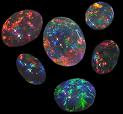Animals
Thursday Thirteen ~ Opals

|
Thirteen Things about Opals

Throughout history, opal has been regarded as a stone of good fortune.
The Romans established opal as a precious gemstone, obtaining their supplies from traders in the Middle East.
The Romans ranked opal second only to emeralds, and carried opal as a good luck charm or talisman because it was believed that like the rainbow, opal brought its owner good fortune.
A Roman Senator by the name of Nonius opted for exile rather than sell his valuable opal to Marc Antony who wanted to give it to his famous lover Cleopatra.
During the late 18th and 19th centuries opal fell out of favour, as it was associated with pestilence, famine and the fall of monarchies.
During the decimation of Europe by the Black Death, it was rumoured that an opal worn by a patient was aflame with colour right up to the point of death, and then lost its brilliance after the wearer died. The superstitious thought the opal had some bearing on the victim's destiny. However, it did not occur to them that the changes in the appearance of the opal was due to the drastic rise and fall of the patient's temperature during their fever and subsequent death.
King Alfonso XII of Spain received an opal ring from a vengeful Comtesse he had previously courted. The King presented the ring to his wife, who had greatly admired it, and shortly thereafter she died mysteriously. A succession of wearers in the royal family followed the Queen's untimely end. Finally, the King placed the opal ring on his own finger and in a little time his life also ended.
Opals have been collected for thousands of years. The oldest opal artifact, estimated to have been collected at around 4000 B.C., was found in a cave in Kenya.
Early Greeks believed opals were the source of prophetic powers.
Opals are found on every continent and in nearly every country. Some pieces are hundreds of pounds, but the vast majority of it is what we term common opal, that is opal without any fire.
Australia is the largest producer of Opals in the world.
Opals are not as hard or as tough as other gemstones, so they can more easily be damaged.
White opals are the most common opals and typically less valuable than the rarer black opals. Black opals are the most sought after color.
|
-
Thursday Thirteen ~ Lapis Lazuli
Thirteen Things about Lapis Lazuli It was among the first gemstones to be worn as jewellery and worked on. It is said that the legendary city of Ur on the Euphrates plied a keen lapis lazuli trade as long ago as the fourth millennium B.C., the...
-
Thursday Thirteen ~ Jade
Thirteen Things about Jade Jade with its discreet yet rather greasy lustre comes in many fine nuances of green, but also in shades of white, grey, black, yellow, and orange and in delicate violet tones. Jade has been known to Man for some 7000 years....
-
Thirteen Things ~ Topaz
Thirteen Things about Topaz Topaz is the birthstone of November (yellow topaz) and December (blue topaz). My youngest son was born in December, so I use blue topaz for his birthstone. It's the suggested anniversary gemstone for the 4th, 19th...
-
Thirteen Things About Sapphires
Thirteen Things About Sapphires Blue is the main colour of the sapphire. The sapphire belongs to the corundum group, the members of which are characterised by their excellent hardness (9 on the Mohs scale). Indeed their hardness is exceeded only...
-
Thursday Thirteen #19
Thirteen Things about Emeralds Fine emeralds are even more valuable than diamonds. The name emerald comes from the Greek 'smaragdos' via the Old French 'esmeralde', and really just means 'green gemstone'. In ancient Rome,...
Animals



